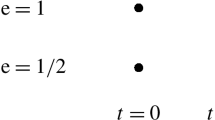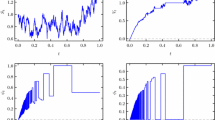Abstract
In the context of a general continuous financial market model, we study whether the additional information associated with an honest time τ gives rise to arbitrage profits. By relying on the theory of progressive enlargement of filtrations, we explicitly show that no kind of arbitrage profit can ever be realised strictly before τ, whereas classical arbitrage opportunities can be realised exactly at τ as well as after τ. Moreover, arbitrages of the first kind can only be obtained by starting to trade as soon as τ occurs. We carefully study the behavior of local martingale deflators and consider no-arbitrage-type conditions weaker than no free lunch with vanishing risk.
Similar content being viewed by others
Notes
We provide an English translation for the convenience of the reader: “For instance, S t may represent the price of some stock at time t, and τ is the optimal time to liquidate a position in that stock. Every speculator strives to know when τ will occur, without ever achieving this goal. Hence the name of an honest random variable”.
We want to point out that analogous results can be obtained if in Assumption 2.6 the NFLVR condition is replaced with the weaker NA1 (or, equivalently, NUPBR) condition (in this regard, see also the discussion in Sect. 7). We also want to make the reader aware of the fact that Assumption 2.6 excludes the classical Black and Scholes [4] model with a non-zero drift coefficient on an infinite time horizon; see e.g. Example 1.7.6 in Karatzas and Shreve [28].
Note that as in Corollary III.4.27 of Jacod and Shiryaev [22], the martingale representation result obtained in Theorem 6.2 of Jeanblanc and Song [23] for bounded \(\mathbb {G}\)-martingales extends naturally to all \(\mathbb {G}\)-local martingales. The representation (3.3) then follows by Lemma 3.3 together with Theorem 6.2 of Jeanblanc and Song [23] and Theorem I.4.61 of Jacod and Shiryaev [22].
We are thankful to an Associate Editor pointing out to us this alternative arbitrage strategy.
References
Ankirchner, S., Imkeller, P.: Finite utility on financial markets with asymmetric information and structure properties of the price dynamics. Ann. Inst. Henri Poincaré B, Probab. Stat. 41, 479–503 (2005)
Ansel, J.P., Stricker, C.: Couverture des actifs contingents et prix maximum. Ann. Inst. Henri Poincaré B, Probab. Stat. 30, 303–315 (1994)
Barlow, M.T.: Study of a filtration expanded to include an honest time. Z. Wahrscheinlichkeit. Verw. Geb. 44, 307–323 (1978)
Black, F., Scholes, M.: The pricing of options and corporate liabilities. J. Polit. Econ. 81, 637–659 (1973)
Cheridito, P., Nikeghbali, A., Platen, E.: Processes of class Sigma, last passage times, and drawdowns. SIAM J. Financ. Math. 3, 280–303 (2012)
Choulli, T., Stricker, C.: Deux applications de la décomposition de Galtchouk–Kunita–Watanabe. In: Azéma, J., et al. (eds.) Séminaire de Probabilités XXX. Lecture Notes in Mathematics, vol. 1626, pp. 12–23. Springer, Berlin (1996)
Chybiryakov, O.: Itô’s integrated formula for strict local martingales with jumps. In: Donati-Martin, C., et al. (eds.) Séminaire de Probabilités XL. Lecture Notes in Mathematics, vol. 1899, pp. 375–388. Springer, Berlin (2007)
Coculescu, D., Jeanblanc, M., Nikeghbali, A.: Default times, no-arbitrage conditions and changes of probability measures. Finance Stoch. 16, 513–535 (2012)
Delbaen, F., Schachermayer, W.: A general version of the fundamental theorem of asset pricing. Math. Ann. 300, 463–520 (1994)
Delbaen, F., Schachermayer, W.: The existence of absolutely continuous local martingale measures. Ann. Appl. Probab. 5, 926–945 (1995)
Delbaen, F., Schachermayer, W.: A simple counter-example to several problems in the theory of asset pricing. Math. Finance 8, 1–11 (1998)
Dellacherie, M., Maisonneuve, B., Meyer, P.-A.: Probabilités et Potentiel, Chapitres XVII–XXIV: Processus de Markov (fin), Compléments de Calcul Stochastique. Hermann, Paris (1992)
Elworthy, K.D., Li, X.M., Yor, M.: The importance of strict local martingales; applications to radial Ornstein–Uhlenbeck processes. Probab. Theory Relat. Fields 115, 325–355 (1999)
Fontana, C.: Four essays in financial mathematics. Ph.D. thesis, Department of Mathematics, University of Padova (2012). (Available upon request from the first author)
Fontana, C.: Weak and strong no-arbitrage conditions for continuous financial markets. (2013, preprint). Available at arXiv:1302.7192 [q-fin.PR]
Grorud, A., Pontier, M.: Asymmetrical information and incomplete markets. Int. J. Theor. Appl. Finance 4, 285–302 (2001)
Hulley, H.: Strict local martingales in continuous financial market models. Ph.D. thesis, University of Technology Sydney (2009)
Hulley, H., Schweizer, M.: M6—On minimal market models and minimal martingale measures. In: Chiarella, C., Novikov, A. (eds.) Contemporary Quantitative Finance: Essays in Honour of Eckhard Platen, pp. 35–51. Springer, Berlin (2010)
Imkeller, P.: Random times at which insiders can have free lunches. Stoch. Stoch. Rep. 74, 465–487 (2002)
Imkeller, P., Pontier, M., Weisz, F.: Free lunch and arbitrage possibilities in a financial market with an insider. Stoch. Process. Appl. 92, 103–130 (2001)
Ingersoll, J.E.: Theory of Financial Decision Making. Rowman & Littlefield, Totowa (1987)
Jacod, J., Shiryaev, A.N.: Limit Theorems for Stochastic Processes, 2nd edn. Grundlehren Math. Wiss., vol. 288. Springer, Berlin (2003)
Jeanblanc, M., Song, S.: Martingale representation property in progressively enlarged filtrations. (2012, preprint). Available at arXiv:1203.1447 [math.PR]
Jeanblanc, M., Yor, M., Chesney, M.: Mathematical Methods for Financial Markets. Springer, London (2009)
Jeulin, T.: Semi-martingales et Grossissement d’une Filtration. Lecture Notes in Mathematics, vol. 833. Springer, Berlin (1980)
Kabanov, Y.: On the FTAP of Kreps–Delbaen–Schachermayer. In: Kabanov, Y., et al. (eds.) Statistics and Control of Stochastic Processes: The Liptser Festschrift, pp. 191–203. World Scientific, Singapore (1997)
Karatzas, I., Kardaras, K.: The numeraire portfolio in semimartingale financial models. Finance Stoch. 11, 447–493 (2007)
Karatzas, I., Shreve, S.E.: Methods of Mathematical Finance. Springer, New York (1998)
Kardaras, C.: Finitely additive probabilities and the fundamental theorem of asset pricing. In: Chiarella, C., Novikov, A. (eds.) Contemporary Quantitative Finance: Essays in Honour of Eckhard Platen, pp. 19–34. Springer, Berlin (2010)
Kardaras, C.: Market viability via absence of arbitrage of the first kind. Finance Stoch. 16, 651–667 (2012)
Kardaras, C.: On the characterisation of honest times that avoid all stopping times. Stoch. Process. Appl. 124, 373–384 (2014)
Kardaras, C., Kreher, D., Nikeghbali, A.: Strict local martingales and bubbles. (2013, preprint). Available at arXiv:1108.4177 [math.PR]
Mansuy, R., Yor, M.: Random Times and Enlargements of Filtrations in a Brownian Setting. Lecture Notes in Mathematics, vol. 1873. Springer, Berlin (2006)
Meyer, P.-A., Smythe, R.T., Walsh, J.B.: Birth and death of Markov processes. In: Le Cam, L.M., Neyman, J., Scott, E.L. (eds.) Proceedings of the Sixth Berkeley Symposium on Mathematical Statistics and Probability, Volume 3: Probability Theory, pp. 295–302. University of California Press, Berkeley (1972)
Nikeghbali, A.: An essay on the general theory of stochastic processes. Probab. Surv. 3, 345–412 (2006)
Nikeghbali, A., Platen, E.: On honest times in financial modeling. Working paper (2008). Available at arXiv:0808.2892 [q-fin.CP]
Nikeghbali, A., Platen, E.: A reading guide for last passage times with financial applications in view. Finance Stoch. 17, 615–640 (2013)
Nikeghbali, A., Yor, M.: Doob’s maximal identity, multiplicative decompositions and enlargements of filtrations. Ill. J. Math. 50, 791–814 (2006)
Protter, P.: Stochastic Integration and Differential Equations, Version 2.1. Springer, Berlin (2005)
Schweizer, M.: Martingale densities for general asset prices. J. Math. Econ. 21, 363–378 (1992)
Schweizer, M.: On the minimal martingale measure and the Föllmer–Schweizer decomposition. Stoch. Anal. Appl. 13, 573–599 (1995)
Song, S.: Drift operator in a market affected by the expansion of information flow: a case study. (2012, preprint). Available at arXiv:1207.1662 [math.PR]
Song, S.: An alternative proof of a result of Takaoka. (2013, preprint). Available at arXiv:1306.1062 [math.PR]
Takaoka, K., Schweizer, M.: A note on the condition of no unbounded profit with bounded risk. Finance Stoch. 18, 393–405 (2014)
Zhang, H., Hadjiliadis, O.: Drawdowns and the speed of market crash. Methodol. Comput. Appl. Probab. 14, 739–752 (2012)
Zwierz, J.: On existence of local martingale measures for insiders who can stop at honest times. Bull. Pol. Acad. Sci., Math. 55, 183–192 (2007)
Acknowledgements
The authors are thankful to the Fédération Bancaire Française (within the chaire “Risque de Crédit” program) for generous financial support and to Anna Aksamit, Ashkan Nikeghbali, Marek Rutkowski, Marc Yor, two anonymous referees an Associate Editor and the Editor (Martin Schweizer) for valuable comments that helped to improve the contents and presentation of the paper.
Author information
Authors and Affiliations
Corresponding author
Appendix
Appendix
1.1 Proof of Lemma 3.5
Due to the representation (3.4), for any \(\mathbb {F}\)-stopping time σ and any local martingale deflator L in \(\mathbb {G}\) on the time interval [0,σ∧τ], we can write
Let us first focus on the term on the second line of (A.1). Recall that τ<ν P-a.s. (see the proof of Proposition 3.1) and that \(Z=\left(Z_{t}\right)_{t\geq0}\) is the \(\mathbb {F}\)-optional projection of \((\mathbf {1}_{\left\{\tau>t\right\}})_{t\geq0}\) and \(Z_{\sigma}/N_{\sigma}=1/N^{*}_{\sigma}\) on the set {σ<ν} (see Lemma 2.10). Then we can write
Let us now compute more explicitly the second term on the right-hand side of (A.1). Recall that \(E[\eta|\mathcal {G}_{\tau-}]=0\) (see Jeanblanc and Song [23], Theorem 6.2). Recall also that since all \(\mathbb {F}\)-local martingales are continuous (by Assumption 2.8 together with the continuity of S), Corollary 2.4 of Nikeghbali and Yor [38] (see also Mansuy and Yor [33], Exercise 1.8) implies that the dual \(\mathbb {F}\)-predictable projection of the process (1 {τ≤t}) t≥0 is given by \((\log N^{*}_{t} )_{t\geq0}\). Moreover, the measure \(dN^{*}_{s}\) is supported by the set \(\{ s\geq0:Z_{s}=1\}=\{s\geq0:N_{s}=N^{*}_{s}\}\). By first taking the \(\mathcal {G}_{\tau -}\)-conditional expectation and then recalling that \(\{\tau>\sigma\}\in \mathcal {G}_{\tau-}\) and that k τ is \(\mathcal {G}_{\tau-}\)-measurable (see Jacod and Shiryaev [22], Proposition I.2.4), we can write
Equation (3.5) then follows by combining (A.2) and (A.3), using the fact that since τ<ν P-a.s., we have σ>τ on the set {σ≥ν}, and noting that the process N ∗ is constant after τ. In order to show that \(\int_{0}^{\tau} \frac{1+k_{s}}{N^{*}_{s}}\,dN^{*}_{s}>0\) P-a.s., it suffices to use the fact that 1+k τ >0 P-a.s. (see Remark 3.4) and note that
which implies that \(\int_{0}^{\tau} \frac{1+k_{s}}{N^{*}_{s}}\,dN^{*}_{s}>0\) P-a.s. The last assertion follows from the fact that the nonnegative \(\mathbb {G}\)-local martingale L σ∧τ is a uniformly integrable \(\mathbb {G}\)-martingale if and only if \(E[L^{\sigma\wedge\tau}_{\infty }]=E[L_{\sigma\wedge\tau}]=1\). Due to (3.5), the latter holds if and only if P(ν≤σ)=0. □
Rights and permissions
About this article
Cite this article
Fontana, C., Jeanblanc, M. & Song, S. On arbitrages arising with honest times. Finance Stoch 18, 515–543 (2014). https://doi.org/10.1007/s00780-014-0231-1
Received:
Accepted:
Published:
Issue Date:
DOI: https://doi.org/10.1007/s00780-014-0231-1
Keywords
- Honest time
- Progressive enlargement of filtrations
- Arbitrage
- Free lunch with vanishing risk
- Local martingale deflator




